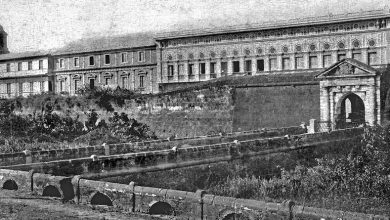The Fortified Town
Intramuros, the old Spanish fortified town, still half in ruins, seems to slumber in the past, with its cobbled lanes and its old palaces; but it contains within its walls, pierced by their seven gates, two buildings of great interest, the church of San Agustin and Fort Santiago.
After taking Manila in 1570-1571 the Spaniards were faced with the necessity of defending the site a necessity rendered more urgent by the sacking of the town by the Chinese pirate Limahong in 1574. The work of fortification took more than three full decades and involved the construction of ramparts of earth, brick and the local volcanic stone (tufa). Within these ramparts was built a town in Spanish style, with narrow streets laid out in a regular grid round the Plaza Mayor. By the 18th century, Manila had eleven churches, three convents, two palaces, the University of Santo Tomas, 88 public buildings and 363 private dwelling houses. Only settlers of Spanish stock were allowed to live within the town: Filipinos and Chinese had to build their houses outside the walls.
In 1603 a moat was constructed to strengthen the town’s defences, but this was drained at the beginning of the American occupation on health grounds and laid out in gardens. At present, the old moat that surrounded Intramuros was transformed into a golf course where locals and foreign nationals play the sport; at the southwest corner is a monument to Legazpi and Urdaneta. The town was entered by seven monumental gates, richly decorated.
In 1863 an earthquake destroyed the Cathedral and the Royal Palace as well as many houses, and the Governor moved over the river Pasig to the Malacañang Palace. At the beginning of the 20th century the Americans contemplated, pulling down the ramparts and laying out a ring of boulevards in their place, but were restrained from carrying out their plan by protests from archaeologists and historians, combined with the efforts of the two daughters of Governor R. Wright. The best preserved sections of the town walls (which escaped damage in 1942 but suffered considerable destruction in 1945) are those on the south side, above the municipal golf course. A number of the gates have been restored: the Puerta Real on the south side (Calle Real de Palacio or General Luna Street); the Puerta de Parian to the east; the Puerta de Isabel II to the north (Magallanes Drive); and the Puerta Postigo and Puerta Santa Lucia to the west (Bonifacio Drive). The governors and archbishops made their solemn entry into the town by the Puerta Postigo de Palacio, and through this gate too, Jose Rizal passed on his way to execution at Luneta. At the roundabout, outside the Puerta Postigo, at the end of Bonifacio Drive, is a monument to Simon de Anda y Salazar, hero of the resistance to the British during the Seven Years War and later a shrewd and enlightened governor.
A plan for the conservation and restoration of Intramuros has been prepared by an architect named Rosary Benitez and approved by the government (1979). After the removal of the present occupants (warehouses, etc.) it is planned to restore the exteriors of the houses to their original state and to establish a museum. In the 1980s under the governance of former Philippine First Lady Imelda Marcos, the Intramuros Adminsitration restored the city and at present the walled city is the only district of Manila where Spanish-era was retained. Much of the development of present-day Manila occurred outside the gates of Intramuros, leaving the old walls, streets and churches of Intramuros minimally touched by modernization. Through the WOW Philippines campaign, Intramuros grew as a prime urban tourist destination in the country.
Intramuros is best seen on foot, and lies within walking distance of the hotels in the city centre; if your hotel is farther away, at Makati or on Roxas Boulevard, take a taxi. A tour takes between 2 and 3 hours. The visit to Intramuros would not be complete without seeing its historic sites.



